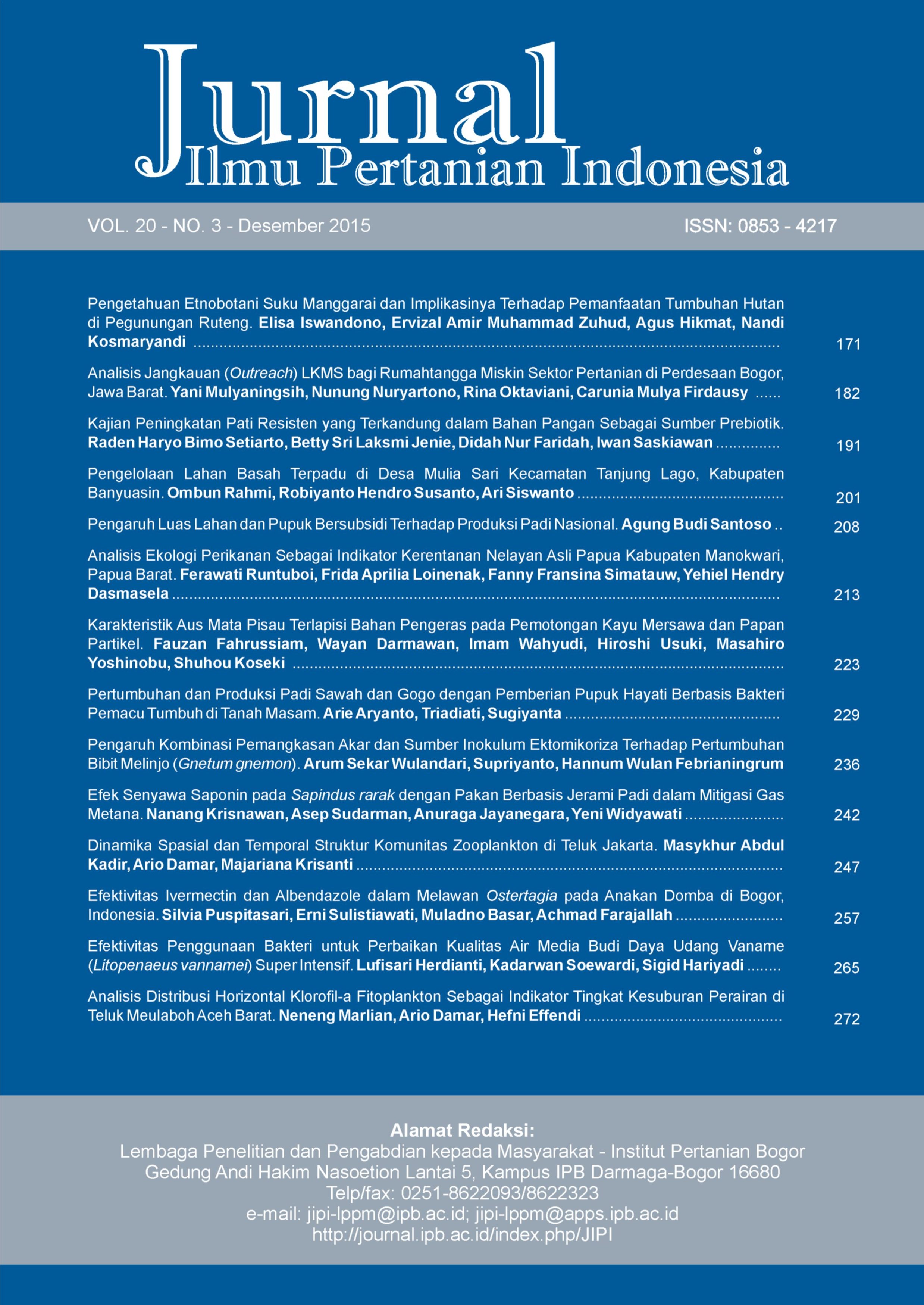Pengaruh Luas Lahan dan Pupuk Bersubsidi Terhadap Produksi Padi Nasional
Abstract
Rice has become a staple food of Indonesia's population. The target of rice self-sufficiency continued to be a priority of the government until 2017. This study aims to analyze land use and subsidized fertilizer that affect national rice production and analysis description of the factors that affect rice production covering the spread and proportion in each of the major islands in Indonesia. The data used in this study was a secondary data derived from agricultural statistics of 2013 issued by the Data Center and Information Ministry of Agriculture. The data was processed using multiple linear regression analysis. The results that the national rice production was affected by land use, realization of subsidized urea fertilizer, realization of subsidized SP-36 fertilizer, and realization of subsidized ZA fertilizer. All of these factors on rice production was inelastic in the short term or long term. Java and Bali Island have the highest proportion in all the factors that affect national rice production.Downloads
References
Badan Pusat Statistik. 2015. Luas Daerah dan Jumlah Pulau Menurut Provinsi, 2002-2013. [internet]. [diunduh 2015 Februari 1] Tersedia pada: http://www.bps.go.id/tab_sub/view.php?kat=1&tabel=1&daftar=1&id_subyek=153¬ab=1
Gujarati D. 1995. Basic Econometrics - Edisi 3. New York (US): Mc-Grawhill.
Hidayat A. 2009. Sumber Daya Lahan Indonesia: Potensi, Permasalahan, dan Strategi Pemanfaatan. Jurnal Sumberdaya Lahan. 3(2): 107-117.
Irawan. 2012. Adaptasi Perubahan Iklim Untuk Mempertahankan Produksi Beras di Pulau Jawa. Dalam: Prosiding Seminar Nasional “Petani dan Pembangunan Pertanian 2012”. Bogor Botani Square, Bogor (ID), 12 Oktober 2011.
Kariyasa K. 2005. Sistem Integrasi Tanaman Ternak dalam Perspektif Reorientasi Kebijakan Subsidi Pupuk dan Peningkatan Pendapatan Petani. Jurnal Analisis Kebijakan Pertanian. 3(1): 68-80.
Kementerian Pertanian. 2013. Statistik Pertanian 2013. Pusat Data dan Sistem Informasi Pertanian, Jakarta (ID).
Kumalasari DA, Hanani N, Purnomo M. 2013. Skenario Kebijakan Swasembada Beras di Indonesia. Habitat. 24(1): 48-63.
Lantarsih R, Widodo S, Darwanto DH, Lestari SB, Paramita S. 2011. Sistem ketahanan Pangan Nasional: Kontribusi Ketersediaan dan Konsumsi Energi serta Optimalisasi Distribusi Beras. Analisis Kebijakan Pertanian. 9(1): 33-50.
Malian AH, Mardianto S, Ariani M. 2004. Faktor-Faktor yang Mempengaruhi Produksi, Konsumsi, dan Harga Beras serta Inflasi Bahan Makanan. Agro Ekonomi. 22(2): 119-146.
Masyhuri. 2008. Situasi Perberasan Nasional dan Prospek Tahun 2008. Pangan. 17(50): 67-72.
Panuju DR, Mizuno K, Trisasongko BH. 2013. The Dynamics of Rice Production in Indonesia 1961–2009. Journal of the Saudi Soceity of Agricultural Sciences. 12(1): 27-37. http://doi.org/75v
Reijntjes C, Haverkort B, Waters-Bayer A. 1999. Pertanian Masa Depan: Pengantar untuk Pertanian Berkelanjutan dengan Input Luar Rendah. Yogyakarta (ID): Kanisius.
Rejekiningrum P. 2009. Sumber Daya Lahan Indonesia: Potensi, Permasalahan, dan Strategi Pemanfaatan. Sumberdaya Lahan. 3(2): 85-96.
Sari RK. 2014. Analisis Impor Beras di Indonesia. Economics Development Analysis. 3(2): 320-326.
Tan S, Heerink N, Kuyvenhoven A, Qu F. 2010. Impact of Land Fragmentation on Rice Producers Effeciency in South-East China. Wageningen Journal of Life Sciences. 57(2): 117-123. http://doi.org/c6n9r9
Wardani A, Isnaeni N, Adnan M, Widayati W. 2014. Pengendalian Konversi Lahan Sawah Menjadi Industri dan Perumahan di Kabupaten Sukoharjo Tahun 20102013. Journal of Politic and Government Studies. 4(1): 46-55.
This journal is published under the terms of the Creative Commons Attribution-NonCommercial 4.0 International License. Authors who publish with this journal agree to the following terms: Authors retain copyright and grant the journal right of first publication with the work simultaneously licensed under a Creative Commons Attribution-NonCommercial 4.0 International License. Attribution — You must give appropriate credit, provide a link to the license, and indicate if changes were made. You may do so in any reasonable manner, but not in any way that suggests the licensor endorses you or your use. NonCommercial — You may not use the material for commercial purposes.






















